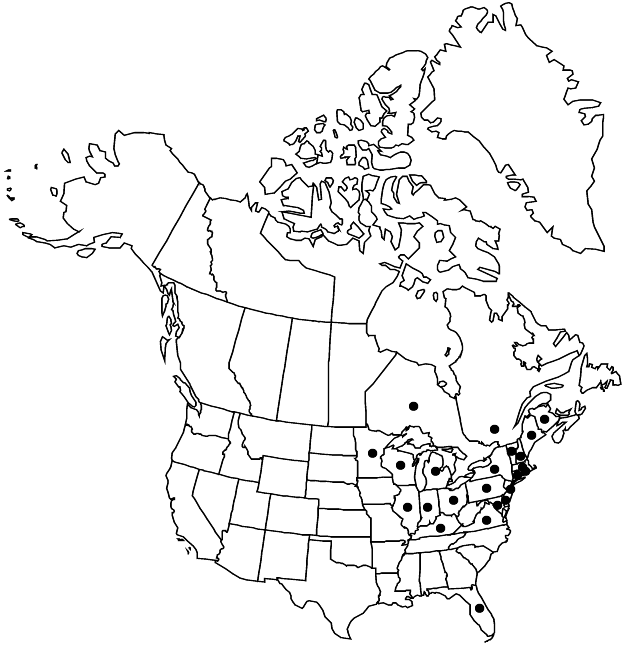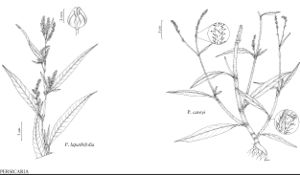Persicaria careyi
Leafl. Bot. Observ. Crit. 1: 24. 1904.
Plants annual, 3–15(–20) dm; roots also rarely arising from proximal nodes; rhizomes and stolons absent. Stems erect, branched distally, ribbed distally, hirsute proximally, stipitate-glandular distally, usually smooth proximally. Leaves: ocrea brownish to reddish brown, cylindric, 8–20 mm, chartaceous, base inflated or not, margins truncate, ciliate with bristles 2–7 mm, surface strigose to hirsute, not glandular-punctate, rarely stipitate-glandular; petiole (0.1–)0.5–1.5 cm, hirsute, leaves sometimes sessile; blade without dark triangular or lunate blotch adaxially, narrowly lanceolate, 6–18 × 1–3.5 cm, base tapering, margins antrorsely strigose, apex acuminate to attenuate, faces sparingly hirsute abaxially and adaxially, veins often hirsute, sometimes stipitate-glandular. Inflorescences terminal and axillary, nodding or drooping, usually interrupted, 10–100 × 5–10 mm; peduncle 20–50 mm, stipitate-glandular; ocreolae overlapping or not overlapping proximally, margins eciliate or ciliate with bristles to 1.3 mm. Pedicels ascending to spreading, 1–4 mm. Flowers (1–)2–8 per ocreate fascicle, homostylous; perianth roseate or purple, glabrous, not glandular-punctate, scarcely accrescent; tepals 5, connate in proximal 1/3, obovate, 2.4–3.2 mm, veins prominent or not, not anchor-shaped, margins entire, apex obtuse to rounded; stamens 5 (or 8), included; anthers pink, elliptic; styles 2, connate to middle. Achenes included, dark brown to black, biconvex, 1.8–2.5 × 1.5–2 mm, shiny, smooth.
Phenology: Flowering Jul–Oct.
Habitat: Low thickets, swamps, bogs, moist shorelines, clearings, recent burns, cultivated ground
Elevation: 0-300 m
Distribution

N.B., Ont., Que., Conn., Del., Fla., Ill., Ind., Ky., Maine, Md., Mass., Mich., Minn., N.H., N.J., N.Y., Ohio, Pa., R.I., Vt., Va., Wis.
Discussion
An infusion made from entire plants of Persicaria careyi was used by the Potawatomi as a cold remedy and febrifuge (D. E. Moerman 1998).
Selected References
None.
